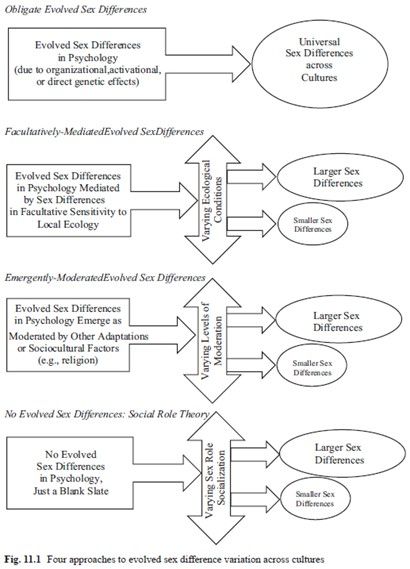Sex
How Can Sex Differences Be Evolved and Culturally Variable?
When socioecology engages with our underlying psychological design.
Posted May 5, 2023 Reviewed by Tyler Woods
Key points
- Psychological differences between women and men often largest in cultures that are most gender egalitarian.
- There is no one Platonic ideal sex difference size that is “the natural” size.
- Evolution doesn’t care much if women and men are psychologically different.
Large cross-cultural studies of human psychology—attempts to document our geographically varying ways of thinking, feeling, and behaving around the world—are becoming more common. Also becoming more common are reports from such studies showing something rather unexpected: Psychological differences between women and men are often the largest in cultures that are the most gender egalitarian.
This so-called gender, or "Nordic," paradox has shown up again and again in studies of cognitive abilities (e.g., mental rotation and object location memory), personality traits (e.g., neuroticism and narcissism), personal values (e.g., benevolence and power), vocational interests (e.g., working with people versus things), moral concerns (concerns for fairness and purity), economic decisions (choosing risk-taking and altruism), levels of aggression (such as physical fighting), features of mental health (e.g., anxiety and depression), subjective well-being, self-esteem, romantic attachment styles, love orientations...and even in physical attributes such as height, blood pressure, facial dimorphism, physical strength, waist-to-hip ratios, and more (for a review, see here; and for details on how many of these sex and gendered variations can be viewed as dimensional, mosaic, and non-binary, see here).
Adding to this growing list of paradoxical findings, a large cross-cultural analysis of human values and attitudes in 2023 found that, “in line with predictions from evolutionary psychology and a growing number of empirical studies in this field, the sex difference in attitudes towards homosexuality widens with rising gender equality and development, especially when the two coincide.”
I thought it might be helpful to write a primer on how one might interpret these types of results, because they can seem quite counter-intuitive and are often interpreted, incorrectly, to mean that the largest sex differences are "natural" sex differences. This is, in almost all cases, simply not true. And it's important to understand why.

Unfortunately, the whole idea that observed phenotypic sex differences can be partly “evolved” and also be culturally variable and strongly influenced by socioecology can be incredibly difficult to grasp (at least for the university students I teach). For a detailed account, I've tried to taxonomically outline some of the basic ways this might occur in this chapter.
To help people understand how evolved sex differences can vary across cultures, perhaps the easiest attribute to consider is the presumably “evolved” sex difference in human height. Although men are generally taller than women (on average), the degree of this difference is highly culturally variable (and can be very small in some populations). How could the human sex difference in height be “evolved” if it isn’t universal, timeless, and exactly the same size in every human culture?
Well, in this case, the cultural variation in sex differences in height likely stems, in part, from harsh socioecologies reducing the size of the observed sex difference. This is because men’s height appears to be more deleteriously affected by poor nutrition and disease than is women’s height. As Gaulin and Boster (1992) noted in their review of sex differences in stature across 155 human societies, “substandard nutrition could cause individuals to fall short of their genetically set growth potential, and, importantly, males seem to be more sensitive to such developmental perturbations than females” (p. 474). This often happens with sexually-selected features, which are, by design, difficult to generate (Geary, 2021), though it's certainly not the case that men show greater phenotypic plasticity or differential susceptibility to all environmental inputs.
Cultural variation in the exact size of sex differences in height itself is probably not “by design” as far as I know (i.e., it is unclear why people's inclusive fitness within a culture would depend on the precise degree to which men are taller than women in that cultural niche). But still, it may be sex differences in the evolved design of the mechanisms that generate height that ultimately cause men to be much taller than women in some cultures more than others. It’s important to note that other factors, such as local population genetics and mate choice, might play key roles, too. (For additional perspectives on how sex differences in undernourishment, development, and patriarchy might influence height, see also here, here, and here.)

See, even with something as tangible and conspicuous as sex differences in height, explaining cross-cultural variation can be quite complicated!
In the case of culturally-variable sex differences in homophobia, it’s even more complicated and I recommend reading the original article for its nuanced views. But to illustrate how this sex difference could be evolved and culturally variable, let’s take a speculative look at how this could work.
Perhaps men possess evolved psychological mechanisms that lead them to develop, more than women do on average, more homophobic attitudes (especially intrasexual homophobia). If so, we shouldn't expect all men everywhere in the world must express homophobia because it is evolved (that would be gender essentialist thinking). Likewise, we shouldn't assume that all men but absolutely no women express homophobia (that would be gender-dichotomized or gender binary thinking), nor that all men must inevitably express this regardless of developmental experiences (biologically deterministic thinking), nor that all men express this to the same degree in every culture (cultural-invariance thinking). These assumptions are all related to what I call Toxic Tetrad misunderstandings of evolved sex differences and how they manifest phenotypically. For more on these and other common misunderstandings of evolutionary psychology, see Schmitt (2023) here and also work by others here and here and here.
Evolved sex differences don't just spring from the forehead of Zeus fully formed and ready for action. Sex differences develop, sometimes zigging or zagging, but almost always requiring important inputs from our gendered bodies (e.g., grip strength), our gendered hormones (e.g., pubertal surges), and at least somewhat reliable gendered cultural forces (e.g., child-rearing norms, collective fighting, and other ancestrally common gendered divisions of labor). Sex differences are built, and evolution has a plan, but there's a lot of room for building modifications.
So, if men do possess evolved mechanisms that, due to their specialized design, predispose the typical man to express more homophobia than we see in the typical woman…when we look across the sea of human cultures, we might well expect men to generally express more phenotypic homophobia than women do. And this is what the researchers in 2023 found. But they also suggested there could be (and likely are) many other factors that accentuate or attenuate this attitude in women and men. And these other factors may be non-randomly distributed around the world in ways that lead to important insights about gendered psychology and its intersection with culture and evolution. In other words, they suggested that sex differences can be both evolved and culturally variable.
One key factor that may influence homophobia: religion. Perhaps some religions (or other socioecological factors) accentuate expressed homophobia to an extreme degree in everyone, leading to no observed sex differences in homophobia. This 2023 article finds that to be the case, noting in such cultures that “disapproval of homosexuality is so entrenched in society that no differences between men and women in this respect can be observed.” In less religious and more “progressive” cultures, where people are more free to express themselves (their personal desires, interests, attitudes, and values), the heightened male homophobia shows up as expected, but women’s homophobia is much lower. In contrast, in more religious, less “progressive” cultures, where everyone is strictly expected to express homophobia, the sex difference is not observed. The evolved sex difference in underlying psychology may still be there (i.e., men more readily develop homophobia), but the observed “no sex difference” in manifest behavior due to religion is masking this underlying psychological potential. Socioecology has trumped evolved psychology.
When it comes to sexuality, lots of “evolved” sex differences may be attenuated or masked by strong social forces such as religion. The members of the Shaker religion expressed very few, if any, sex differences in manifest sexual behavior, as men and women were barely allowed to touch one another in those communities. Of course, there aren’t a lot of Shakers around anymore. Even if there were, though, the behaviorally sex-similar Shakers wouldn’t negate the existence of evolved sex differences in psychological mechanisms, the sort of mechanisms that, at least in most cultures, do manifestly generate sex differences in sexual behavior.
Evolutionary psychologists expect religion and other socioecological factors to sometimes overwhelm our evolved sex differences. And at other times certain socioecological factors are actually expected to adaptively accentuate or attenuate certain sex differences (that is, our evolved psychology is “on the lookout” for certain pieces of cultural information, feeding this information adaptively into men’s and women’s differential psychological development). Thus, sex difference variation is expected when we look across the vast hyperspace of human cultural possibilities. What researchers have found are predictable patterns within that hyperspace: Patterns of sex differences uniquely discernible and explainable when using an evolutionary psychology perspective.
To make sense of these patterns, most psychological researchers have traditionally turned to social role theory and the importance of social learning. Social role theory is a powerful theory, and it is more than obvious that women and men are affected by the gendered social roles we are allowed to and expected to inhabit. In this instance of explaining homophobia across cultures, however, the blanket social role prediction that increasing similarity in women’s and men’s social opportunities for education, wealth, government service, and so forth should reduce the sex difference (as Eagly et al., 2004, stated..."as societies become more egalitarian, men and women become more similarly positioned in the social structure and, therefore, more similar psychologically...this demise of many sex differences with increasing gender equality is a prediction of social role theory”) just doesn't pan out.
The expected social role theory pattern was clearly not what the 2023 researchers observed with regard to homophobia. For some reason, they—and so many others—have found the exact opposite of what social role theory predicts. In the cultures where women and men inhabited very different social roles (indeed, women were strictly prohibited from many social roles in the least gender egalitarian cultures), the sex differences were the smallest! My guess, in this case, is that religion (among other cultural factors) is accentuating women’s homophobia to match men’s higher levels. It will be interesting as more research reveals why this and so many other psychological and physical attributes are expressed most differently by women and men when living within the most gender egalitarian cultures in the world (see here and here).
One final point, and it’s probably the most important. Just because sex differences are largest in the most gender egalitarian and richest nations of the world (e.g., Nordic nations) doesn’t mean the Nordic-sized sex differences are “natural” and all other nations just aren’t reaching their true “sex difference potential.” That could be true for some attributes, but I doubt it’s true for many (if any). For almost all human attributes, there is no one Platonic ideal sex difference size that is “the natural” size.
Instead, some of the time, sex differences vary across cultures in ways influenced by sex-specific evolutionary mechanisms, and in each culture, the size of the sex difference makes the most adaptive sense for that local socioecology. But even more often, the evolved mechanisms might not be producing “functionally-sized” sex differences, per se. Instead, sex differences emerge simply because the evolved mechanisms of women and men are designed somewhat differently (e.g., sex differences in height might result from this). In these cases, sex differences are variable across cultures for "evolved" reasons, but not because the size of the sex difference is of particular importance. And for many other sex differences, there are myriad factors at play beyond evolved mechanisms that are generating the culturally-variable sex differences observed around the world.
To take a specific psychological example, there is probably no “natural” level of sex difference in the personality trait of neuroticism. It is true that in most studies women score higher than men on neuroticism and neuroticism-related traits of fearfulness, anxiety, depression, and so forth; and it is true that these sex differences vary in size around the world. However, instead of one size being some sort of Platonic ideal of sex differences in neuroticism, women’s and men’s neuroticism levels vary cross-culturally because the many evolved psychological mechanisms that feed the development of neuroticism, fearfulness, anxiety, and depression are different in women and men. These mechanisms are properly reacting to the varying socioecological factors that impact neuroticism the most, depending on one's sex (see also here and here and here and here).
It's also the case that a broad trait like neuroticism contains many component parts, each of which might differ in women and men for different reasons. For instance, recent evidence suggests much of the sex difference in fearfulness (but not the other parts of neuroticism) is due to sex differences in physical strength, so in cultures where women and men have more similar levels of strength, sex differences in neuroticism should be attenuated. Whether this turns out to be true or not, the key point here is that the actual size of the sex difference in neuroticism doesn’t matter for evolution (metaphorically speaking). Evolution doesn’t care much if women and men are psychologically different, it just cares whether women and men (and their evolved psychologies) are each responding functionally to the socioecologies in which they reside. Perhaps psychologists should follow evolution’s lead. Focus less on the size of the sex difference and more on how women and men differentially respond to what their socioecology presents to them.




